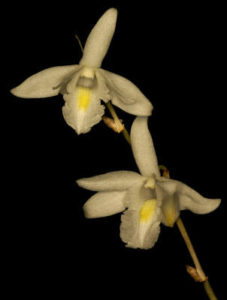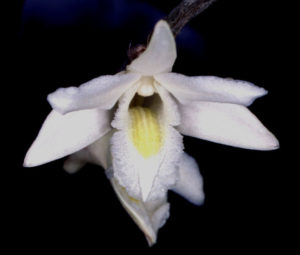The following article was written for the Orchid Species Bulletin published by the Orchid Species Society, which is based in Brisbane, Queensland in March 2010.
Bear in mind that any cultivation notes refer to the subtropical conditions of Southern Queensland, Australia.
 Ceraia saaronica (J.König) M.A.Clem. & D.L.Jones is better known as Dendrobium crumenatum Sw. Johann König first described this species as Epidendrum saaronicum in Fasciculus Observationum Botanicarum in 1791. Olof Swartz described it again as Den. crumentatum in Schrader’s Journal fur die Botanik in 1799.
Ceraia saaronica (J.König) M.A.Clem. & D.L.Jones is better known as Dendrobium crumenatum Sw. Johann König first described this species as Epidendrum saaronicum in Fasciculus Observationum Botanicarum in 1791. Olof Swartz described it again as Den. crumentatum in Schrader’s Journal fur die Botanik in 1799.
Recent morphological and molecular studies show that the generic limits of Dendrobium need to be reviewed. Based upon these studies, Mark Clements and David Jones transferred Epi. saaronicum to the genus Ceraia Lour. in The Orchadian in 2002.
Ceraia are epiphytic or lithophytic plants that have pseudobulbous stems that may be up to 1 m long. The basal swollen portion of the stem comprises 3-4 nodes. A covering sheath encloses very short inflorescences in the upper portion that bear 1-3 flowers. Flowering occurs spontaneously at any time following a drop in air temperature, so that all plants bloom at the same time. The flowers last for only a few hours or perhaps are only open for one day. Fragrantly perfumed, the flowers have a long column-foot to which the lip is attached at the base, forming a spur containing nectar.
Cr. saaronica has thin cane-like stems that are 40-70 (-100) cm long. The stems are swollen for 3-4 nodes at the base as yellowish-green, spindle-shaped pseudobulbs that are 6-8 cm long and 1.5-2 cm broad. The pseudobulb becomes ribbed with age and the lower portion of the upper stem bears up to 12 alternating two-ranked leaves. Very leathery, the oblong-lanceolate to oblong-obovate leaves are about 6-7 cm long and 2-2.5 cm broad.

The remaining uppermost portion of the stem of Cr. saaronica is leafless and bears bracts along its length. Single flowers that are 2.5-4 cm across are produced sporadically from each of the bracts along the leafless portion. Simultaneous flowering is triggered 9 days after a sudden temperature drop, which usually occurs after a thunder storm. Pure white with yellow on the disc of the lip, the showy strongly fragrant flowers last for one day. Large plants may be smothered in white flowers, making a spectacular sight.
Widespread throughout southeast Asia, Cr. saaronica is distributed from India, Sri Lanka, the Andaman Islands, Myanmar, Thailand, Laos, Cambodia, Vietnam, Peninsular Malaysia, Indonesia, Borneo, Sulawesi, Taiwan and the Philippines. This species requires a well-drained medium, bright light such as 50-70% shade and good air circulation. It is a warm-growing species that does best with a winter minimum of 15-18oC. In the southeast Queensland region, water it regularly during the warmer months and give it a slightly drier winter rest. Leaf drop may occur when temperatures drop below 12oC.
